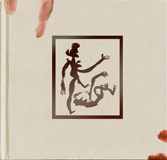
| Jacket 40 — Late 2010 | Jacket 40 Contents | Jacket Homepage | Search Jacket |
This piece is about 4 printed pages long.
It is copyright © Keith Leslie Johnson and Jacket magazine 2010. See our [»»] Copyright notice.
The Internet address of this page is http://jacketmagazine.com/40/r-baby-leg-rb-johnson.shtml
Brian Evenson
Baby Leg
reviewed by
Keith Leslie Johnson
106 pp. Tyrant Books. www.nytyrant.com/home.html. US $35 cloth.

1
One of the most bizarre subgenres of exploitation film is what we would have to call the “amputation melodrama”: Wallace Worsley’s The Penalty (1920) and Tod Browning’s The Unknown (1927), both starring Lon Chaney, are the earliest examples I know; their self-ironic progeny include Jennifer Lynch’s Boxing Helena (1993) and Guy Maddin’s Cowards Bend the Knee (2003). In all these films, amputation is usually an image or index of otherwise invisible psychosexual trauma. [1] From a Lacanian perspective, I suppose, we are all of us amputees in the sense that we have been severed from “the phallus” by our entrance into language, but I mention that only to indicate, lamely, the universality of the amputation-theme. It seems to rest at the crux, or on the crutch, of a whole host of profound issues (not least of which is artistic taste).
2
Amputation also has its literary history, of course, going back at least as far as the story of Tantalus and Pelops (was his ivory shoulder the first prosthetic?); then there are Jacobean revenge dramas, the Marquis de Sade, and later still Bataille’s Histoire de l’oeil, and O’Connor’s “Good Country People,” Beckett’s Endgame, Bernhard’s Die Billigesser, Dunn’s Geek Love, Wallace’s Infinite Jest, Coetzee’s Slow Man, and on and on. As with their cinematic cousins, these literary instances often hobble a fine line between tackiness and pathos. To my mind, the most fascinating recent meditation on the “poetics” of amputation, one that brings together both cinematic shock and literary subtlety, has come in the form of a pseudo-trilogy by Brian Evenson: the chapbook Brotherhood of Mutilation(2003), its novel-length expansion Last Days(2009), and finally Baby Leg, a signed, limited-edition novella released in November 2009 as the inaugural offering of NYC-based Tyrant Books.

Brian Evenson (publisher’s publicity photgraph)
3
The relation of these three works might fancifully be conceived as that of stump, prosthesis, and phantom limb. Brotherhood of Mutilation follows a former-detective named Kline who is hired to infiltrate an amputation cult as part of an internal murder investigation. He seems the perfect choice for the job, having cut off his own shackled hand in the line of duty, cauterized the stump on a nearby hotplate, and killed his would-be attacker. (He gets a lot of points from cult members for being a “self-cauterizer.”) Things, however, get a little complicated to say the least. What ensues is a nightmarish descent into the hermetic world of the cult, its tangle of secrets, illogic, and betrayal. Ultimately, for Kline the descent is (perversely) therapeutic, shocking him out of indolent self-pity; but at what cost?
4
Last Days is essentially the unaltered text of Brotherhood of Mutilation cosmetically sutured to a follow-up novella (also called “Last Days”) in which Kline discovers that some rabbit holes have rabbit holes of their own, that there are zealots even among zealots. Between the two novellas is a period of blackout. Kline wakes up in a hospital some few days after the events of the earlier novella and eventually finds himself trapped in a well-appointed mansion full of blond-haired amputees named Paul (both to signify the Apostle Paul and Wittgenstein’s brother, Paul, who was a one-armed pianist). The Pauls are schtum on all the whys and wherefores, but that’s okay because the decor itself speaks volumes: two paintings in particular are set apart as objects for Kline’s contemplation; one is clearly meant to be Odd Nerdrum’s “One Story Singer” while the other, a faceless portrait, is harder for me to place. Francis Bacon? Adrian Ghenie? I admit I’m (wait for it) stumped.
5
There isn’t a strict continuity between these works and Baby Leg, more a resonance of images and ideas, but the connection seems stronger for all that, the way an itch in a phantom limb can be itchier than a real itch precisely because it’s hallucinated. Like Kline, the protagonist of Baby Leg, Kraus, is an amputee. Or at least he thinks he is. We are first introduced to Kraus as the victim of a dream, pursued by “a woman with a normal leg and a baby leg” (1).
6
In the dream, she clomped about on her adult-sized knee and the baby leg, wielding an axe, lurching. He kept watching her pass, yawing with each step. He would hear her first, the thud of the knee and the soft slap of the baby foot, and then see her come by, slow and off-kilter, the sound of her slowly fading. (ibid)
7
If that image is frightening and grotesque, it’s also just overwrought enough to be darkly comedic as well. Baby Leg, as she comes to be known, exists first as an acoustic menace — the thud-slap of her gait — before she materializes in the visual. Is she real? Part of some fever dream? Or an artifact of post-hypnotic suggestion? After all, Kraus isn’t alone. Vaguely psychiatric forces are after him; he seems to have escaped from an institution or criminal enclave during an experimental procedure: there is Varner, the Dr. Mabuse of the book, Paolo, a heavy, Gladys, Lefort. [2] A clinical setting is implied and then undermined. Perhaps he has committed a crime; perhaps he is being prepared to commit a crime; perhaps this preparation is itself a crime. Kraus spends most of the novella either hiding in an abandoned cabin or detained in an indeterminate facility, holding gnomic conversations with Varner, Baby Leg, and even his own skeleton.
8
So again, what, if anything, is real and, more chillingly, how would one ever know? Adding to Kraus’ disorientation, and the reader’s, is the effective erasure of his memory: there is simply no ground in which he might anchor himself, neither perception nor past experience. Apart from being an “amputation melodrama,” then, Baby Leg is also an amnesia story and post-psychotic fantasy. Even if it isn’t as fully rendered or imagined as the first two parts of the pseudo-trilogy, there is an immense pleasure to be had in its vertiginous dissolves between “dream” and “reality.” In fact, few authors can really pull off the kinds of bravura rhetorical effects that Evenson achieves here, nor can many do it with his economy of style.
9
After a while, he got up and dragged the bodies outside, one by one. Later that night, lying in bed, he heard the sounds of wolves or feral dogs fighting over them, tearing them apart. Not real, he told himself. He couldn’t sleep. He got up and built a fire and lit it and sat in front of it in the wingback chair and watched the flames. He was waiting for something to happen, he wasn’t sure what. After a while he fell asleep. (100)
10
The repetition of the prepositional phrase in this, the penultimate, paragraph of the novella signals the kind of fugue-state Kraus (and the reader) has entered. [3] Between these two periods of sleep, hallucination and reverie come to him as consolation and to us as confusion. The world has become, as it were, a phantom limb of the mind, cleft from itself.
11
Baby Leg certainly stands (ahem) on its own merits as a novella, but I think it can also be profitably read within the continuum of Evenson’s work I’ve suggested as well as the broader literary and cinematic history of amputation. It will appeal to fans of speculative and experimental fiction as well as those who enjoy psychological horror. We should, however, avoid the temptation to ghettoize Evenson as a genre-writer even as he consistently deploys the tropes. The stakes have always been much higher in his fiction and, as a result, so have the payoffs. It is as if he had one stump in the world of camp and the other in the world of high art, as if the audacity of Tod Browning were coupled with the austerity of Beckett. A worldly Worsley, a kitschy Coetzee! At any rate, here he comes, folks, blood on his undershirt, wielding an axe.
[1] Interestingly, in their later films, like The Hunchback of Notre Dame (1923; again starring Chaney) and Freaks (1932), this relation will be inverted. In these films, a kind of counter-physiognomy is at work: physical disfigurement becomes the index of psychological normalcy! The real monsters, the real freaks, are the petty, intolerant rabblement of common folks. If the conceptual horizon of their earlier films is the vexed inner life of the individual, then that of these later films broadens to entail the social and political as such.
[2] Evenson’s character-names, often Continental, tend to invite allusive or metonymic speculation. “Lefort,” for example, immediately brings to mind well-known French psychoanalyst Rosine Lefort, whose book Naissance de l’Autre is almost certainly known to Evenson. It is a moving account of her attempts to guide two disturbed children, one psychotic and the other autistic, through Lacanian analysis. Is this a clue, a coincidence, a red herring?
[3] The prolific Evenson’s short-story collection, Fugue State, also appeared in 2009 from Coffee House Press.

(Left:) Keith Leslie Johnson
Keith Leslie Johnson’s recent and forthcoming articles can be found in Modernist Cultures, the Journal of the Kafka Society of America, and Twentieth-Century Literature, among others. He is an Assistant Professor of English & Foreign Languages at Augusta State University.